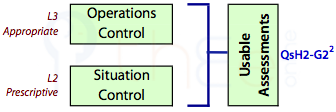Foci of Dialogue

Authority & Influence
The Dyads ensure choices attend to the broader longer-term value-driven scene while dealing effectively with presenting specifics. Within an organization, those at the higher level require legitimate authority to enforce their views. It is now evident that carrying such authority should be based (among other things) on a personal capability to perceive/construct a more complex reality. That enables effective influence. (If capability is lacking, there is avoidance of discussion, crude imposition or power manipulations: key features of the «bad boss»![]() .)
.)
The internal structure of the dyadic dialogue reveals:
- g2: a higher orienting Level authorized to handle the more abstract and general issues in relation to any choice within the focus. Here we find clarification of reasons, definition of boundaries, reaffirmation of values and needs, and the brute assertion of policies and priorities: the over-riding requirement is that the judgement must be appropriate.
- g1: a lower implementing Level authorized to handle the fine matching of specifiable action to current realities of the relevant situation. These include pressing demands, obstacles and unavoidable constraints. Practicalities shape possible options, strategies and tactics in relation to g2, whose output is taken as prescriptive.
Note that while cooperation-based dialogue is the essential integrating link applicable throughout this hierarchy, full line-management authority is not applicable above . ![]() More
More
Zones of Communication
Even the best-formulated policies and rules never exactly suit all instances, and implementation invariably throws up policy issues that require definitive handling. So managers at adjacent levels must discuss in a cooperative spirit to settle the broader objectives and appreciate the finer practicalities.
Lower level staff must be empowered to check, suggest and protest decisions handed down to them. Line-managers must therefore (in general) handle subordinates by:
- valuing consulting and one-to-one dialogue,
- using management team meetings to listen and explore, as well as to brief,
- being prepared to zoom down into lower levels to see for themselves,
- employing staff officers to stay in touch as well as to monitor and coordinate,
- consulting with managers in different but related areas of the organization.
Virtual dialogue: Most decisions are made without face-to-face meetings because most dialogue in practice is implicit or virtual. Before and while proceeding, the staff-member mentally considers the views and needs of their line-manager.
falls into three distinct zones, named: Political, Managerial and Front-line. ![]() Click to see.
Click to see.
Political Zone
The upper two arrangements require discussions on how to think about work and duties in any and every fundamental respect. Because thinking about values is not controllable, discussion is collegial and line-management does not apply.
Workable Conceptions: G26
Organizations cannot simply assimilate general ideas from anywhere. It is never clear what they mean, how they apply or what adaptations are needed locally. By general ideas, I refer to notions like: safety, quality (e.g. TQM), efficiency (e.g. just-in-time), corporate citizenship. Even «needs» and «services» start as ideas requiring clarification.
Operational Frameworks: G25
Operations must function within policy frameworks: this may refer to rules, to strategies, or to major initiatives intrinsic to the organizational identity (as typically expressed via new ).
Managerial Zone
The middle two arrangements require dialogues on how to provide organizational services that ultimately deliver products &/or services for customers/clients.
Organised Services: G24
All operations consist of organised services of one sort or another. In a business, the principal departments typically include marketing, production, and R&D: each of which may have a range of services. However, there is also a range of support services covering facilities, personnel, finance &c.
Service Standards: G23
Every service needs to operate to agreed standards and follow certain operational policies in relation to a range of measures relevant to both quantity and quality. While organizational values may guide the approach, each specific service is distinctive. That uniqueness is only properly appreciated and handled by those directly responsible for the professional and technical activities.
Front-line Zone
(or Professional Zone)
The lowest two arrangements require dialogue on how to deal with specific concrete situations and cases (units) in the workflow that present from moment to moment in a dynamic environment.
Usable Assessments: G22
Proven methods and operational policies needs to govern assessments. However, the appropriateness of an assessment when carried out within an organization is not solely a disciplinary or occupational matter (as it could be for a sole practitioner). Certain modes of assessing or assessment judgements might be prohibited due to resource limitations, higher level policies or current priorities.
Adapted Outputs: G21
Every situation is different. So no policy or system can ever cover all possibilities and it is always necessary to adapt to the immediate reality and yet provide an acceptable output. Acceptability applies in two directions: towards the outside world and within the organization. Here existing arrangements need to be put into a perspective suiting every particular case and the output adjusted accordingly.
Next Step
is not enough to ensure management cooperation when there is severe resistance or disputes. That can happen when uncertainty is high, something which is common in a changing environment. A dynamic approach to cut through opposition is then necessary.
Higher level frameworks and policies point to the future and foster such dynamism. However, of any sort disrupt the status quo, and potentially put existing operations at risk. Specific arrangements are therefore required to avoid turmoil caused by forceful impulsiveness, while countering the natural tendency to weaken any drive for change.
- can be driven sensibly by combining levels in threes (i.e. ).
Originally posted: 19-Mar-2014





